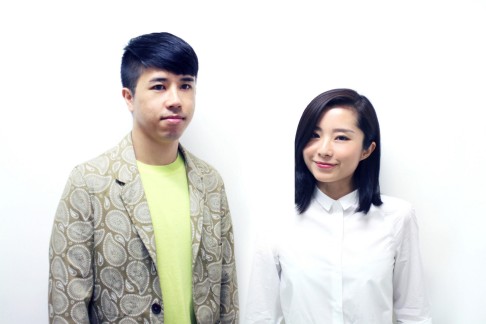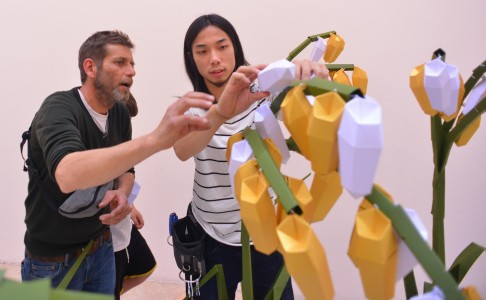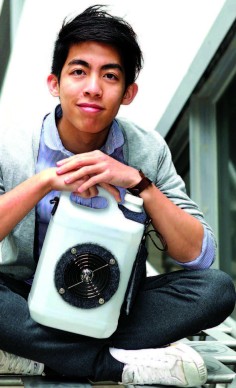
Exhibition gives visitors a taste of Hong Kong through dynamic designs
An exhibition at Milan Design Week gave visitors a taste of Hong Kong in a dynamic, multimedia showcase, writesTamsin Bradshaw

Scenes flash by in seconds: one moment the Star Ferry speeds across a sunlit Victoria Harbour; the next, baristas at a Sheung Wan coffee shop are seen busily making brews, and then images of street vendors flash past. This series of fleeting, ever-changing impressions was part of an exhibition, appropriately named Hong Kong: Constant Change, at this year's Milan Design Week.
The multimedia showcase featured film and music by Italian composer Ludovico Einaudi, products, live creation by some of the participating designers, and a mobile app that interacted with Quick Response (QR) codes to give viewers extra interviews and insights with some of the 60 designers involved.
It was part of a wider series of exhibitions at Milan's Triennale Design Museum, one of many outposts in the city that hosted creative events this month.
Danish architect Nille Juul-Sørensen, who is also director of the Danish Design Centre, curated Hong Kong: Constant Change on behalf of organisers, the Hong Kong Design Centre.
"I decided I would like to present young designers," says Juul-Sørensen, 55. "Hong Kong has a lot of designers my age who are really famous, which is great, but there's a whole population of designers out there who are really cool [and much younger]. It's sort of street but not street. It's got a complexity to it."
And it was this "street" idea that inspired the concept for the whole exhibition.
"I thought, 'Let's be on a street in Hong Kong for nine minutes,'" says Juul-Sørensen, who dreamed up the idea of a physical street complete with road markings and hugged on two sides by a whirlwind of Hong Kong images accompanied by fast-paced music by Einaudi.
"Hong Kong is New York on steroids," says the show's curator. "In one way it's totally disjointed, it's chaotic. And you have this juxtaposition of old and new. There's constant change going on - if you visit a place and come back two weeks later, the whole fabric might have changed."
Kevin Cheung, a product designer participating in the exhibition, agrees. "Hong Kong is a very materialistic city. Everyone's always chasing the latest trend, changing phones. There's a lot of waste material."

The designer's Bottle Chimes installation, a key element of the Milan exhibition, sees him reuse plastic bottles collected from a plastic recycling facility in Tsuen Wan, transforming them into ethereal, glowing pendant lights.
Sustainability is central to the work of many of the up-and-coming designers who exhibited at Hong Kong: Constant Change.
"We think it's a basic element of design," says Michael Leung, one half of Miro, a design duo formed by two Hongkongers who studied at Design Academy Eindhoven in the Netherlands.

For Hong Kong: Constant Change, Chan and Leung designed tables and benches made of untreated, eco-friendly pine mixed with scrap wood and metal, both of which are generally used in construction processes.
"Both materials are hidden materials," says Chan. "Few realise their beauty."
The furniture emphasises the craftsmanship and skill involved with carpentry, an approach that infuses much of Miro's work.

Also playing with craft at the exhibition was Stickyline, a design studio that works with three-dimensional forms crafted out of paper. The work of studio founders Mic Leong and Soilworm Lai brings new meaning to origami: the designers can create everything from giant sharks to the rice stalks they were working on at Hong Kong: Constant Change. Their intention was to fill the whole floor by working with visitors to the exhibition, showing them how to fold pieces of paper to create the stalks.
"We're building a farm with our paper art. We want to create a fun, interactive atmosphere using our language," says Leong, who started out designing toys before joining forces with Lai, who has a background in package design.
Also present at the exhibition was designer Eileen Chan of The Yesterdayskin, a fashion label that reworks vintage clothing found at flea markets and in second-hand stores. "I work on the cutting, the silhouettes and the fit to create a new collection," says Chan. "I'm not chasing trends and I'm not doing mass production."
Chan's participation in Hong Kong: Constant Change has one big difference from that of Stickyline, Miro and Cheung: her work was part of the digital side of the event, with information, images and interviews with her downloadable via an app and QR codes on display around the show. Other designers going the digital route included Michael Young, Anthony Lo (who designs for French carmaker Renault), Milk Design, Vivienne Tam and Barney Cheng.
It was the first time the event had gone digital, says Edmund Lee, executive director of the Hong Kong Design Centre. "We wanted to present Hong Kong as a robust, and at the same time, very dynamic city."
The designers also demonstrated an exciting approach to sustainability. And Juul-Sørensen's nine-minute film captured the beauty and intensity of Hong Kong.
"I wanted to make Hongkongers proud of their city," he says. "All the shots were taken without filters, so it's just smack-bang in-your-face. And that makes Hong Kong for me."
Hong Kong: Constant Change will be on display at the newly opened PMQ on Aberdeen Street in July.